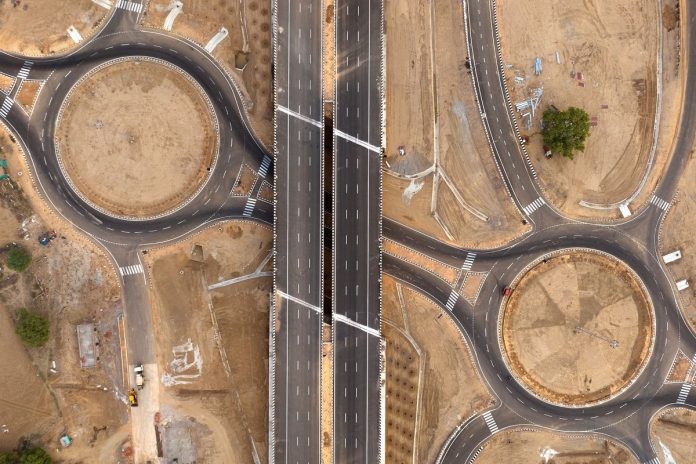Snapshot
-
The expressway has major economic implications as it will serve the key mineral producing regions of Eastern India.
The corridor will also unite the two cultural capitals of the country, Varanasi and Kolkata, with significant reduction in travel time.
The National Highways Authority of India (NHAI) has invited bids for six-lane greenfield Varanasi-Ranchi-Kolkata expressway.
The 610-km-long Varanasi-Kolkata corridor is an access-controlled expressway with a route alignment connecting Varanasi in Uttar Pradesh, Ranchi in Jharkhand, and Kolkata in West Bengal.
The expressway under Bharatmala Pariyojna (BMP) Phase 2 has been planned to provide high-speed connectivity to the northern and eastern regions of the country.
Passing Though Four States
The expressway starts from the junction of National Highway (NH)-19 and Varanasi Ring Road (near Rewasa village) and terminates at NH-16 near Uluberia in Howrah district in the state of West Bengal.
It will cover a distance of 22 km in Uttar Pradesh, 159 km in Bihar, 187 km in Jharkhand and 242 km in West Bengal.
The greenfield corridor starting from Varanasi will pass through Chandauli in Uttar Pradesh; Kaimur, Rohtas, Aurangabad and Gaya districts of Bihar, and traverse through Chatra, Hazaribagh, Ramgarh, and Bokaro districts of Jharkhand.
From here it will reach Kolkata connecting Purulia and Bankura, West Medinipur, Hooghly and Howrah in West Bengal.

Scope
The NHAI has currently invited bids for two packages on Hybrid Annuity Mode (HAM).
The first package is a 27-km stretch between Varanasi Ring Road and Chandauli-Cainpur road in Uttar Pradesh and Bihar at an estimated value of Rs 988.24 crore.
Another tender involves a 27-km stretch from Chandauli-Chainpur Road to junction with Bhabhua-Adhaura Road in Bihar at a cost of Rs 945.24 crore.
Alternative To NH-2
At present it takes at least 12 to 13 hours to cover 644 km between Varanasi and Kolkata via NH-2 (Golden Quadrilateral Road).
The Varanasi-Kolkata expressway which will run parallel to NH-2 will reduce the travel time to 7-8 hours.
Even though the two roads differ only slightly in length, the greenfield expressway allows higher speed limits (~100 km/hr) being outside the periphery of the cities and elimination of major choke points.
Connection To Industrial Corridors
To be built at a cost of Rs 30,000 crore, the expressway has major economic implications as it will serve the key mineral producing regions of eastern India — Jharkhand, Bihar and West Bengal.
Further as part of synergy with Prime Minister (PM) Gati Shakti, the expressway shall be connected to major industrial nodes.
These include electronic manufacturing centres at Falta and Naihati, fishing seafood cluster at Ranchi, Howrah, Nadia and Hooghly; pharma and medical cluster at Behala and textile cluster at Howrah, Varanasi and Bhadohi.
Improving Logistics
The major reduction in travel time coupled with uninterrupted traffic flow will improve the efficiency of freight movement to/from the eastern region of the country.
The large consumer base of West Bengal, and the emerging consumer bases in states like Bihar, Odisha, Jharkhand and North-East India, serve as springboard for movement of goods into and within the region.
In addition to this, the Eastern India region also offers a diverse mix of industries like jute, leather, tea, locomotives, steel and mining, each of which contribute more than 20 per cent of their respective national output.
Estimates indicate that the five states of West Bengal, Bihar, Odisha, Jharkhand and Assam will grow on to contribute more than a quarter of India’s Gross Domestic Product (GDP) by 2035, with West Bengal capturing nearly 15 per cent, thus representing a healthy growth curve for the logistics sector to ride on.
Bringing Shiva And Kali Closer
The Varanasi-Kolkata corridor will unite the two cultural capitals of the country, Varanasi and Kolkata.
Riding on this expressway, a devotee would take about 7-8 hours to reach from Kashi Vishwanath Temple in Varanasi to Kalighat Temple in Kolkata, paying his obeisance to both Shiva and Kali in a day.
Further, the government is working on a strategy to connect other major religious places of Eastern India with this expressway.
The major religious places to be connected include Maa Mundeshwari temple in Kaimur, Deo Sun temple in Aurangabad, Mahabodhi temple in Gaya, Bhadrakali temple in Chatra, Rajarappa of Ramgarh and Luguburu Ghantabari in Bokaro.


